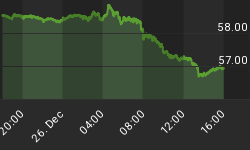How expensive was the 16-day partial shutdown of the U.S. government? According to ratings agency Standard & Poor's, it may have cost the economy a staggering $24 billion.
Millions of government workers were laid off without pay during those two weeks, and many contractors with government ties were hit as well. During that period of uncertainty these households made significant cutbacks in discretionary purchases which created a ripple effect felt by many smaller businesses, particularly in the service sector. There were reports of some businesses which relied heavily on government contract work laying off workers or going out of business entirely.
It would be a mistake to over-blow the effects of the shutdown, but to minimize its impact would be equally foolish. The shutdown had definite repercussions for many workers, some of which are still being felt. The fear and uncertainty the shutdown generated was, while detrimental to the economy, beneficial to gold and silver. Metals and mining stock prices have risen in the wake of the shutdown as investors turn their collective attention once again to the traditional safe havens. It's clear that investors remain uncertain about the future as can be seen in the price of gold (below), which one analyst has called the "price of fear."
While many pundits tried to underplay the economic impact of the shutdown, there's no denying it did more harm than good to the economy. It can also be viewed as symptomatic of a much bigger problem in Washington, namely a continuing trend toward economic obstructionism in the name of party politics. This trend is itself a microcosm of the much larger trend of fiscal austerity which Washington has firmly embraced in recent years.
Politicians and bureaucrats are reactionary by nature, so we can automatically classify the austerity mindset as a reaction to the economic pain caused by the 2007-2009 financial panic and recession. This momentous event left a deep and indelible psychological scar in the minds of policymakers and it continues to motivate their collective thinking (if it can be called that) and legislative efforts. It has also helped to frame the political agenda for the critical year ahead - a period in which the historic 120-year cycle of inflation/deflation is bottoming. This cycle promises to usher in many important changes; indeed, we've already witnessed one important change to the system. Starting in 2014 universal healthcare coverage will be mandated in the U.S., a landmark step on the road to full-scale economic autocracy.
If not for the continuous fiscal crises created by Congress over the past two years, two million more Americans would have jobs. Moreover, unemployment would have dropped under 6.7 percent and GDP growth would be around 4 percent stead of the current 2.5 percent. These statistics are the conclusion of a study by Macroeconmoic Advisers, a nonpartisan consulting firm. The analysis also found that Congress's fiscal-cliff and debt-ceiling blunders have roiled financial markets and caused employers to cut back on prospective hiring. It has also kept consumers from spending more as the entire system has become "paralyzed with uncertainty."
The study concluded that the economy is being actively sabotaged by members of Congress who exert a disproportional influence over the nation's financial affairs. When such is the case, it can only be a matter of time before Washington trips up the recovery altogether.
As impressive as the recovery since 2009 has been, Washington's continuous meddling threatens to derail it in 2014. The introduction of mandatory health insurance next year will create a drag on the economy at the worst possible time, namely while the 120-year cycle of inflation/deflation is bottoming. The timing couldn't possibly be any worse. The Bernanke Fed "gets it" and clearly understands the danger of the deflationary undercurrent created by the long-term Kress cycle.
Washington, for its part, doesn't get it. Both Congress and the president are fighting the Fed by embracing austerity-type measures that will inhibit growth, including tax hikes. This will create significant economic headwinds for next year. On the plus side, it may end up benefiting gold as fear and uncertainty rise in the face of Washington's economic sabotage.
As the Wall Street bromide says, "Sooner or later politics always interferes with business." Policymakers seem intent on proving the truth of this saying. Unfortunately, everyone must reap the consequences.
Stock Market Cycles
Take a journey with me as we uncover the yearly Kress cycles - the keys to unlocking long-term stock price movement and economic performance. The book The Stock Market Cycles covers each one of the yearly cycles in the Kress Cycle series, starting with the 2-year cycle and ending with the 120-year Grand Super Cycle.
The book also covers the K Wave and the effects of long-term inflation/deflation that these cycles exert over stock prices and the economy. Each chapter contains illustrations that show exactly how the yearly cycles influenced stock market performance and explains where the peaks and troughs of each cycle are located and how the cycles can predict future market and economic performance. Also described in this original book is how the Kress Cycles influence popular culture and political trends, as well as why wars are started and when they can be expected based on the Kress Cycle time line.
Order today and receive an autographed copy along with a copy of the booklet, "The Best Long-Term Moving Averages." Your order also includes a FREE 1-month trial subscription to the Gold & Silver Stock Report newsletter:
http://clifdroke.com/books/Stock_Market.html

















